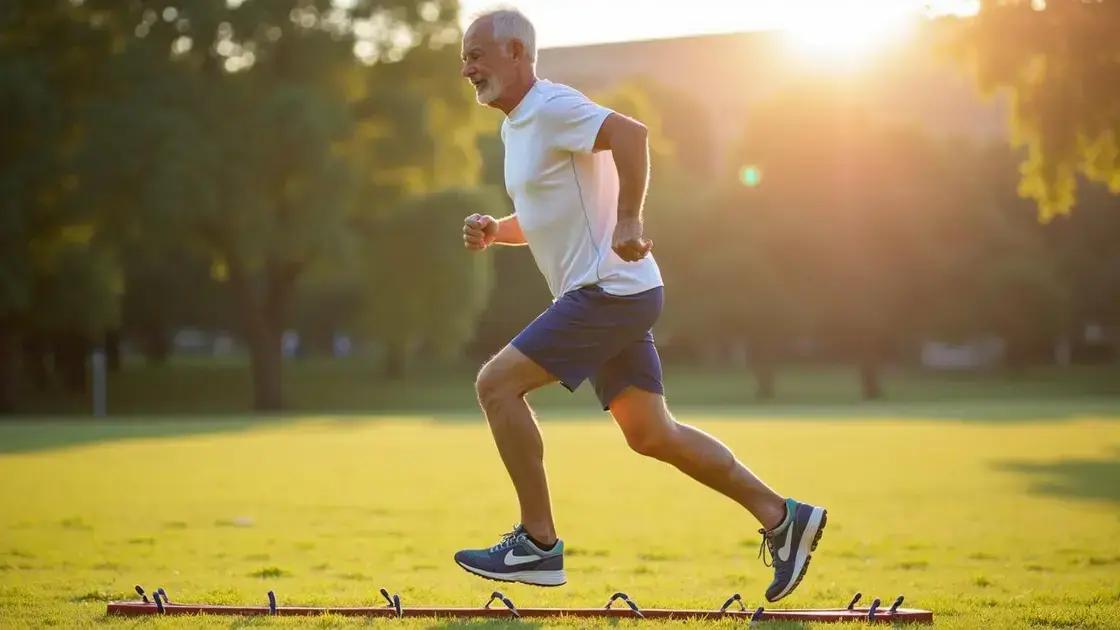Improving agility in your 50s is essential for maintaining balance, mobility, and overall quality of life. Engage in targeted exercises, follow proper nutrition, and stay consistent with your training to enhance your physical capabilities and reduce the risk of injuries.
Improving agility in your 50s can greatly enhance your quality of life. As we age, maintaining agility is crucial for mobility and overall fitness. Engaging in specific exercises and embracing lifestyle changes can enable you to stay active and independent. In this article, we will cover essential steps you can take to improve agility, including effective exercises, nutritional advice, and tips for maintaining a consistent routine.
Understanding Agility and Its Importance in Your 50s

Agility refers to the ability to move quickly and easily. It is not just about speed; it encompasses balance, coordination, and flexibility. As we reach our 50s, agility becomes increasingly important. Staying agile helps us prevent falls, maintain independence, and enhances overall physical performance.
Why Agility Matters in Your 50s
During our 50s, our bodies naturally undergo changes. Muscle mass tends to decline, and joint stiffness can become more common. This makes daily activities, from climbing stairs to playing with grandchildren, more challenging. By focusing on agility, we can combat these changes.
Improved agility also plays a significant role in enhancing quality of life. When you have better agility, you can participate in leisure activities, sports, and even group exercises. This not only keeps you physically active but also boosts mental health by reducing feelings of isolation.
How Agility Impacts Daily Life
Agility affects everything from your ability to navigate obstacles to your reaction times. Simple tasks like getting up from a chair or stepping off a curb can become easier when you maintain your agility. This helps prevent injuries and contributes to a healthier lifestyle.
Moreover, agility training can improve your confidence in movement. When you feel capable and steady, you are more likely to engage in social activities and enjoy your hobbies, which is essential for emotional well-being.
Start Focusing on Agility Today
Understanding its importance is the first step. With a commitment to enhancing your agility, you will take charge of your health as you navigate your 50s. This proactive approach not only safeguards your current mobility but can also pave the way for a more vibrant and active lifestyle in the years to come.
Top Exercises to Enhance Agility

Incorporating specific exercises can significantly enhance your agility as you age. Here are some of the top exercises to help improve agility in your 50s:
1. Lateral Shuffles
Lateral shuffles help improve side-to-side movement and coordination. Start by standing with your feet shoulder-width apart. Shuffle to one side, then back, while keeping a low stance. Repeat for 30 seconds.
2. Heel-to-Toe Walk
This exercise enhances balance and stability. Walk in a straight line by placing the heel of one foot directly in front of the toes of the other. Focus on maintaining steady movement. Aim for 10 steps forward and then return.
3. Agility Ladder Drills
If you have access to an agility ladder, use it for various footwork drills. Quick in-and-out steps or side-to-side movements can increase foot speed and coordination. Spend about 10 minutes practicing different patterns.
4. Single-Leg Stands
Stand on one leg for 30 seconds, then switch to the other. This simple exercise improves balance and strengthens the muscles around your ankles and knees. Increase difficulty by closing your eyes or standing on a pillow.
5. Box Jumps
Start with a low box or step. Jump onto the box with both feet, and step back down. This exercise builds explosive power and agility. Begin with 5-10 jumps and gradually increase as you feel comfortable.
Combining these exercises into your routine can lead to great improvements in your agility. Remember to focus on proper form and control to prevent injury.
Nutrition Tips for Better Movement

Nutrition plays a critical role in supporting better movement and agility, especially in your 50s. Here are some key nutrition tips for improving your overall movement:
1. Stay Hydrated
Drinking enough water throughout the day is essential for keeping your joints lubricated and muscles functioning well. Aim for at least 8 cups of water daily, adjusting based on your activity level.
2. Prioritize Protein
Including sufficient protein in your diet helps maintain muscle mass, which is vital for agility. Incorporate lean meats, fish, beans, and dairy into your meals. Aim for a protein source at each meal.
3. Focus on Whole Grains
Whole grains such as brown rice, oats, and quinoa provide long-lasting energy. They are also rich in fiber, which can help with digestion. Opt for whole grains instead of refined grains to improve stamina during your exercises.
4. Incorporate Healthy Fats
Healthy fats from sources like avocados, nuts, and olive oil are essential for joint health. These fats can help reduce inflammation, so add them to your meals when possible.
5. Eat Colorful Fruits and Vegetables
Fruits and vegetables are packed with vitamins and minerals that support muscle function and recovery. Aim to fill half your plate with a variety of colorful produce to ensure you get a range of nutrients.
By following these nutrition tips, you can enhance your mobility and agility as you age. Remember that what you eat can significantly impact your performance in daily activities and exercises.
How to Stay Consistent with Your Agility Training

Staying consistent with your agility training is crucial for achieving lasting results. Here are some effective strategies to keep you on track:
1. Set Clear Goals
Define what you want to achieve with your agility training. Whether it’s improving speed, balance, or overall mobility, having clear goals will help keep you focused and motivated.
2. Create a Schedule
Set aside specific times each week dedicated to agility training. Treat these sessions as important appointments. Consistency helps build habits, so try to stick to your schedule as much as possible.
3. Use a Variety of Workouts
Incorporate different exercises to prevent boredom. Mixing up agility drills, strength training, and flexibility routines will make your workouts more enjoyable and effective. This variety keeps your body challenged and engaged.
4. Find a Workout Buddy
Training with a friend or family member can make workouts more fun and rewarding. A workout buddy can help motivate you, track your progress, and hold you accountable.
5. Track Your Progress
Keep a journal or use a fitness app to log your workouts. Tracking your progress helps you see improvement over time, which can boost your motivation. Celebrate small victories to stay encouraged!
6. Stay Flexible
Life can be busy, and it’s okay if you need to adjust your schedule. If you miss a training session, don’t get discouraged. Simply reschedule and continue with your routine. The key is to remain committed to your goals.
By following these tips, you can maintain consistency in your agility training and enjoy the numerous benefits it brings to your overall health.
Embrace Agility for a Vibrant Life
Improving agility in your 50s is an achievable goal that can greatly enhance your overall quality of life. By understanding the importance of agility, incorporating targeted exercises, and focusing on proper nutrition, you can significantly boost your mobility and strength.
Consistency is key to success, so be sure to create a structured plan and stay committed to your agility training. Remember to set realistic goals, track your progress, and seek support from others to keep you motivated.
With dedication to these simple steps, you can enjoy better balance, improved coordination, and greater energy, leading to a more active and fulfilling lifestyle.
FAQ – Frequently Asked Questions about Improving Agility in Your 50s
Why is agility important as we age?
Agility helps maintain balance, coordination, and mobility, reducing the risk of falls and making daily activities easier.
What are some exercises to improve agility for those in their 50s?
Exercises like lateral shuffles, heel-to-toe walks, and agility ladder drills can enhance agility. Also, consider incorporating single-leg stands and box jumps.
How can nutrition affect my agility training?
Proper nutrition, including adequate hydration, protein, healthy fats, and a variety of fruits and vegetables, supports muscle function and recovery.
How can I stay consistent with my agility training?
Set clear goals, create a schedule, track your progress, and consider working out with a buddy to help maintain accountability.
Is it necessary to consult a professional before starting an agility training program?
While not mandatory, consulting a fitness professional can provide personalized guidance and ensure you perform exercises safely.
How often should I train for agility?
Aim for at least two to three sessions per week, mixing agility exercises with strength and flexibility workouts to achieve balanced fitness.













